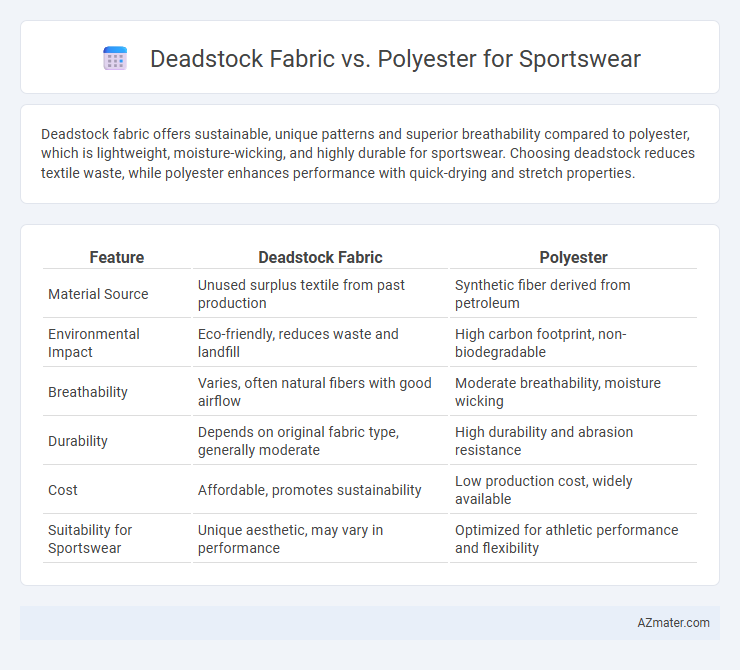Deadstock fabric offers sustainable, unique patterns and superior breathability compared to polyester, which is lightweight, moisture-wicking, and highly durable for sportswear. Choosing deadstock reduces textile waste, while polyester enhances performance with quick-drying and stretch properties.
Table of Comparison
| Feature | Deadstock Fabric | Polyester |
|---|---|---|
| Material Source | Unused surplus textile from past production | Synthetic fiber derived from petroleum |
| Environmental Impact | Eco-friendly, reduces waste and landfill | High carbon footprint, non-biodegradable |
| Breathability | Varies, often natural fibers with good airflow | Moderate breathability, moisture wicking |
| Durability | Depends on original fabric type, generally moderate | High durability and abrasion resistance |
| Cost | Affordable, promotes sustainability | Low production cost, widely available |
| Suitability for Sportswear | Unique aesthetic, may vary in performance | Optimized for athletic performance and flexibility |
Understanding Deadstock Fabric: An Eco-Friendly Alternative
Deadstock fabric, consisting of unused, surplus textiles from previous manufacturing runs, offers an eco-friendly alternative to polyester in sportswear by reducing waste and minimizing environmental impact. Unlike polyester, which is derived from petroleum and contributes to microplastic pollution, deadstock fabrics repurpose existing materials, supporting sustainable fashion practices. Choosing deadstock fabric in sportswear production enhances resource efficiency and promotes circularity in the textile industry.
What Is Polyester and Why Is It Popular in Sportswear?
Polyester is a synthetic fiber made from petroleum-based products, known for its durability, moisture-wicking properties, and quick-drying capabilities, making it ideal for sportswear. Its resistance to shrinking, stretching, and wrinkles ensures long-lasting performance during intense physical activities. The combination of affordability, lightweight texture, and ease of care contributes to polyester's widespread popularity in athletic apparel manufacturing.
Sustainability Comparison: Deadstock Fabric vs Polyester
Deadstock fabric, derived from surplus or leftover materials, significantly reduces textile waste and the environmental impact associated with new production, making it a sustainable choice for sportswear. In contrast, polyester, a synthetic fiber produced from petroleum, contributes to microplastic pollution and has a high carbon footprint due to energy-intensive manufacturing processes. Choosing deadstock fabric over polyester in sportswear supports circular fashion principles and lowers ecological harm while maintaining performance standards.
Performance and Breathability in Athletic Wear
Deadstock fabric, often made from natural fibers like cotton or wool, offers superior breathability and moisture-wicking properties essential for athletic wear, promoting enhanced comfort during intense physical activities. Polyester, a synthetic fiber, excels in durability and quick-drying capabilities but tends to retain heat and moisture, which may reduce overall breathability and lead to discomfort. For performance sportswear, deadstock fabric provides a more sustainable choice with natural ventilation, while polyester is advantageous for its lightweight resilience and ease of maintenance.
Environmental Impact: Life Cycle and Waste Reduction
Deadstock fabric minimizes environmental impact by repurposing excess textile inventory, reducing waste and the need for new resource extraction, unlike polyester which is derived from petrochemicals and contributes to microplastic pollution during washing. The life cycle of deadstock fabric involves less energy consumption and lower carbon emissions since it avoids fiber production and dyeing processes common in polyester manufacturing. Utilizing deadstock fabric in sportswear promotes circular fashion and supports waste reduction goals, contrasting with polyester's challenges in biodegradability and its accumulation in landfills.
Cost and Availability Considerations
Deadstock fabric offers a cost-effective and environmentally sustainable option for sportswear by repurposing unused textiles, often available at lower prices due to surplus stock. Polyester, a synthetic fiber produced in large quantities, provides consistent availability and affordability, benefiting mass production needs in sportswear manufacturing. While deadstock fabric availability can be limited and inconsistent, polyester ensures steady supply and competitive pricing, making it ideal for brands prioritizing scalability and cost control.
Moisture-Wicking and Odor Control Capabilities
Deadstock fabric, often made from natural fibers like cotton or bamboo, offers moderate moisture-wicking but tends to retain odor due to limited antimicrobial properties. Polyester, commonly used in sportswear, excels in moisture-wicking by rapidly drawing sweat away from the skin and features built-in odor control through antimicrobial treatments or synthetic fibers that inhibit bacteria growth. Choosing polyester enhances athletic performance with superior dryness and prolonged freshness compared to deadstock fabric's environmental benefits but lower technical functionality.
Durability and Longevity of Sportswear Materials
Deadstock fabric, often composed of natural fibers like cotton or wool, offers superior breathability but may have varied durability depending on its original purpose and fiber content. Polyester, a synthetic fiber known for its exceptional tensile strength and resistance to abrasion, provides enhanced durability and longevity, making it ideal for high-performance sportswear subjected to frequent wear and washing. While deadstock fabric can offer sustainability benefits by reducing waste, polyester sportswear ensures longer-lasting garments that maintain shape and performance over time.
Fashion and Design Flexibility
Deadstock fabric offers unique, limited-edition patterns and textures, enhancing the exclusivity and aesthetic appeal of sportswear designs, while promoting sustainable fashion by repurposing surplus materials. Polyester excels in design flexibility with its lightweight, durable, and moisture-wicking properties, enabling sportswear that combines performance with a wide range of colors and finishes. Integrating deadstock fabric with polyester can create innovative, eco-friendly sportswear collections that balance distinct fashion appeal and high functionality.
Which Fabric is Best for Your Sportswear Brand?
Deadstock fabric offers sustainable, unique textile options with limited environmental impact, making it ideal for eco-conscious sportswear brands prioritizing originality and quality. Polyester excels in durability, moisture-wicking, and quick-drying properties, ensuring high performance and comfort in intense athletic activities. Choosing between deadstock fabric and polyester depends on whether sustainability or optimal athletic functionality is the priority for your sportswear line.

Infographic: Deadstock Fabric vs Polyester for Sportswear
 azmater.com
azmater.com